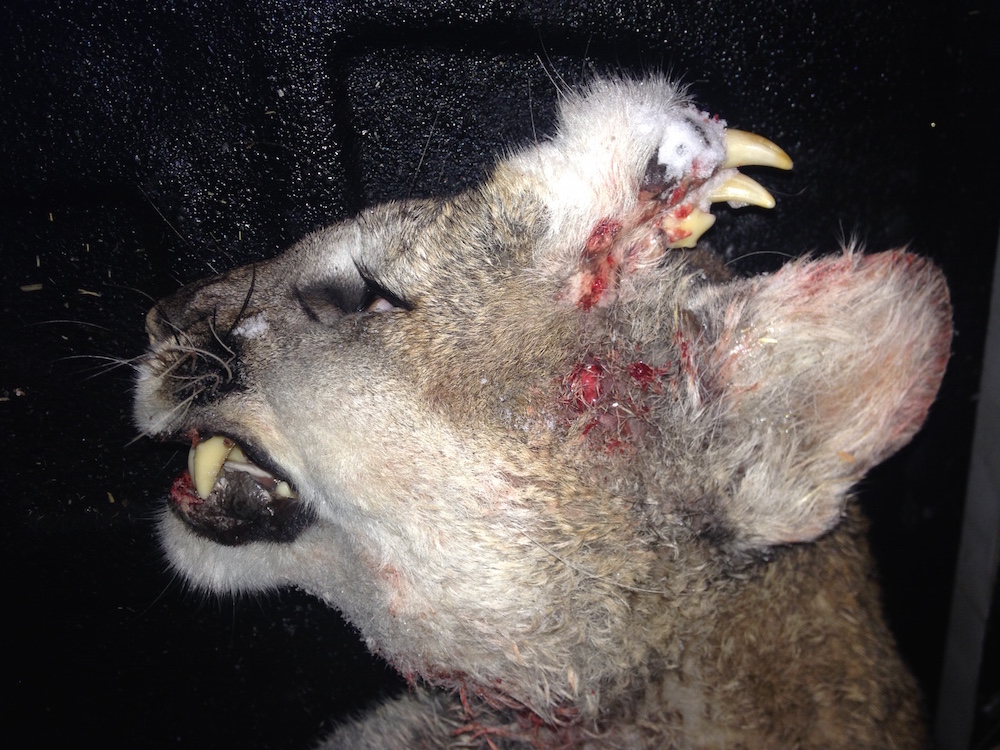Forehead Teeth? 'Deformed' Mountain Lion Puzzles Experts

A hunter recently crossed paths with a rare cat: a mountain lion with extra teeth and white whiskers on the top of its head, the Idaho Department of Fish and Game reported.
The hunter spotted the young male mountain lion near Preston, a city in southeastern Idaho, on Dec. 30, 2015. The hunter saw the mountain lion attack a dog on private property before running off into the hills, the department said in a statement.
With the help of hounds, the hunter tracked the mountain lion for 3 hours before legally harvesting it. The dog involved in the earlier attack survived, the department said. [Photos: Mountain Lion Family Feast]
But the mountain lion was far from an ordinary cat, the hunter found. It had fully formed canine teeth and small whiskers growing out of fur-covered tissue on the left side of its forehead, the department said.
It's unclear what caused the unusual growth, but state biologists offered two ideas. Perhaps the teeth are the remains of a conjoined twin that died in the womb, but was absorbed by the surviving fetus, the biologists said.
Or, maybe the abnormality is a teratoma tumor; these are masses filled with teeth, hair and sometimes even fingers and toes. The tumors contain tissue found in early stage embryos. They're usually benign and don't spread to other parts of the body, researchers told Live Science last year.
These tumors are uncommon in humans and animals, but cases still pop up in the medical literature. For instance, a teratoma tumor in an Indiana woman's brain contained hair, bones and teeth, Live Science reported in April. In another case, a 4-month-old infant in Maryland had a teratoma in his brain that contained fully formed teeth, but surgeons were able to remove the growth.
Sign up for the Live Science daily newsletter now
Get the world’s most fascinating discoveries delivered straight to your inbox.
Yet, the exact cause of the mountain lion's abnormality is anyone's guess, the department said.
"Biologists from the southeast region of Idaho Fish and Game have never seen anything like this particular deformity before," the department said in the statement.
The hunter reported the harvest to the Department of Fish and Game, and a conservation officer verified that the hunter had a valid hunting license and tag. The officer also recorded information about the mountain lion and how it was killed, and pulled a tooth for age analysis, the department said. But the hunter was not required to give the animal to the department for further analysis.
Mountain lions are a native game species in Idaho. But "because of their elusiveness and wariness, human encounters with mountain lions are rare," the department said.
However, the cat's prey animals, including deer and wild turkeys, move to lower elevations during the winter to escape the cold and snow, prompting the mountain lions to follow their prey into areas that boarder on rural or urban communities. When this happens, mountain lions occasionally have run-ins with people, livestock and pets.
Just like elk and mule deer, mountain lions can be legally hunted in Idaho. But the big cats can be pursued only during certain seasons in designated areas, and only if the hunter owns an appropriate license and tag, the department said.
Typically, hunters can harvest one mountain lion per year. Hunters can also use hounds if they have the appropriate hound hunter permit, the department said.
Follow Laura Geggel on Twitter @LauraGeggel. Follow Live Science @livescience, Facebook & Google+. Original article on Live Science.

Laura is the archaeology and Life's Little Mysteries editor at Live Science. She also reports on general science, including paleontology. Her work has appeared in The New York Times, Scholastic, Popular Science and Spectrum, a site on autism research. She has won multiple awards from the Society of Professional Journalists and the Washington Newspaper Publishers Association for her reporting at a weekly newspaper near Seattle. Laura holds a bachelor's degree in English literature and psychology from Washington University in St. Louis and a master's degree in science writing from NYU.










